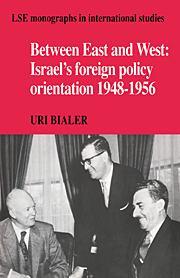Book contents
- Frontmatter
- Contents
- Acknowledgments
- INTRODUCTION
- Part I THE INTERNAL DIMENSION
- Part II RED STAR OVER ZION
- Part III THE WESTERN CONNECTION
- 9 THE MILITARY AND ECONOMIC DIMENSIONS
- 10 FROM NEUTRALITY TO THE SEARCH FOR A LINK
- 11 SOLIDIFICATION OF A WESTERN ORIENTATION
- 12 FAILURE OF “FACTS AND PACTS” POLICY
- EPILOGUE: “A people that dwells alone”?
- Appendix 1 U.N. voting record
- Appendix 2 Biographical notes
- Appendix 3 Israel's votes at the U.N.
- Index
- LSE MONOGRAPHS IN INTERNATIONAL STUDIES
11 - SOLIDIFICATION OF A WESTERN ORIENTATION
Published online by Cambridge University Press: 24 November 2009
- Frontmatter
- Contents
- Acknowledgments
- INTRODUCTION
- Part I THE INTERNAL DIMENSION
- Part II RED STAR OVER ZION
- Part III THE WESTERN CONNECTION
- 9 THE MILITARY AND ECONOMIC DIMENSIONS
- 10 FROM NEUTRALITY TO THE SEARCH FOR A LINK
- 11 SOLIDIFICATION OF A WESTERN ORIENTATION
- 12 FAILURE OF “FACTS AND PACTS” POLICY
- EPILOGUE: “A people that dwells alone”?
- Appendix 1 U.N. voting record
- Appendix 2 Biographical notes
- Appendix 3 Israel's votes at the U.N.
- Index
- LSE MONOGRAPHS IN INTERNATIONAL STUDIES
Summary
While Israel's representatives in Washington worked to interest the Americans in various strategic plans at the end of 1950, policymakers in Jerusalem were confronted with a new problem. Acting on the several hints which had been dropped in the United States, the British made a significant move. On 15 January 1951, William Strang (Permanent Under-Secretary at the British Foreign Office) asked Israel's Ambassador in London to obtain his government's authorization for a visit to the country by General Robertson. As presented by Strang, the British plan was to use the visit to explore the idea of a pact with Israel, or as he put it: “Some kind of alliance with [Israel] either on a regional basis [if possible] or also bilateral.” Specifically, he had two concrete ideas in mind. One was the establishment of British bases in Gaza which might be connected by a corridor to Jordan; the other was the construction of British bases in Israel itself. The feeling in Israel was that both suggestions had arisen as a result of the difficulties which the British were encountering in negotiations for the continued maintenance of their bases in Egypt.
In Jerusalem, Robertson's visit was authorized. The proposals which Strang submitted before Robertson's arrival, however, became the subject of debate at the very highest level. The full details of the discussions are not known although it is clear that among the participants were Ben Gurion, Sharett, Walter Eytan (Director General of the Foreign Ministry), Michael Comay (who was the ministry official responsible for the British Commonwealth) and Reuven Shiloah, an influential security and intelligence expert.
- Type
- Chapter
- Information
- Between East and WestIsrael's Foreign Policy Orientation 1948–1956, pp. 235 - 255Publisher: Cambridge University PressPrint publication year: 1990



